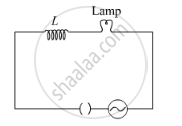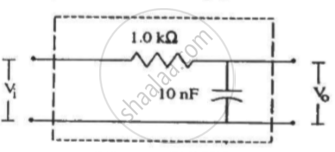Advertisements
Advertisements
प्रश्न
In previous questions 3 and 4, what is the net power absorbed by each circuit over a complete cycle. Explain your answer.
उत्तर
In the inductive circuit,
rms value of current, I = 15.92 A
rms value of voltage, V = 220 V
Hence, the net power absorbed can be obtained by the relation,
P = VI cos `phi`
Where,
`phi` = Phase difference between V and I
For a pure inductive circuit, the phase difference between alternating voltage and current is 90°, i.e., `phi` = 90°.
Hence, P = 0, i.e., the net power is zero.
In the capacitive circuit,
rms value of current, I = 2.49 A
rms value of voltage, V = 110 V
Hence, the net power absorbed can be obtained as:
P = VI Cos `phi`
For a pure capacitive circuit, the phase difference between alternating voltage and current is 90°, i.e., `phi` = 90°.
Hence, P = 0, i.e., the net power is zero.
APPEARS IN
संबंधित प्रश्न
Ajit had a high tension tower erected on his farm land. He kept complaining to the authorities to remove it as it was occupying a large portion of his land. His uncle, who was a teacher, explained to him the need for erecting these towers for efficient transmission of power. As Ajit realised its significance, he stopped complaining.
Answer the following questions:
(a) Why is it necessary to transport power at high voltage?
(b) A low power factor implies large power loss. Explain.
(c) Write two values each displayed by Ajit and his uncle.
In a series LR circuit, XL = R and power factor of the circuit is P1. When capacitor with capacitance C such that XL = XC is put in series, the power factor becomes P2. Calculate P1/P2
A lamp is connected in series with an inductor and an AC source. What happens to the brightness of the lamp when the key is plugged in and an iron rod is inserted inside the inductor? Explain.

An alternating emf of 220 V is applied to a circuit containing a resistor R having the resistance of 160Ω and a capacitor ‘C’ is series. The current is found to lead the supply voltage by an angle
`θ = tan^(-1) ("3/4")`
a) Calculate
1) The capacitive reactance
2) The impedance of the circuit
3) Current flowing in the circuit
b) If the frequency of the applied emf is 50 Hz, what is the value of the capacitance of the capacitor ‘C’?
An A.C. generator generating an emf of ε = 300 sin (100 πt) V is connected to a series combination of 16μ F capacitor, 1 H inductor and 100 Ω resistor.
Calculate :
1) An impedance of the circuit at the given frequency.
2) Resonant frequency `f_0`
3)Power factor at the resonant frequency `f_0`.
The power factor of an a.c. circuit is 0.5. What is the phase difference between voltage and current in this circuit ?
For a given a.c., i = im sin ωt, show that the average power dissipated in a resistor R over a complete cycle is `1/2I_m^2` R .
Define the quality factor in an a.c. circuit. Why should the quality factor have high value in receiving circuits? Name the factors on which it depends.
A coil has a resistance of 10 Ω and an inductance of 0.4 henry. It is connected to an AC source of 6.5 V, `30/pi Hz`. Find the average power consumed in the circuit.
In a series LCR circuit with an AC source, R = 300 Ω, C = 20 μF, L = 1.0 henry, εrms = 50 V and ν = 50/π Hz. Find (a) the rms current in the circuit and (b) the rms potential difference across the capacitor, the resistor and the inductor. Note that the sum of the rms potential differences across the three elements is greater than the rms voltage of the source.
Following figure shows a typical circuit for a low-pass filter. An AC input Vi = 10 mV is applied at the left end and the output V0 is received at the right end. Find the output voltage for ν = 10 k Hz, 1.0 MHz and 10.0 MHz. Note that as the frequency is increased the output decreases and, hence, the name low-pass filter.
Answer the following question.
Show that an ideal inductor does not dissipate power in an ac circuit.
Suppose the circuit has a resistance of 15 Ω. Obtain the average power transferred to each element of the circuit, and the total power absorbed.
Which of the following quantities remains constant in a step-down Transformer?
The series combination of R, L, C is connected to an a.c. source. If the resistance is 3 and the reactance is 4, the power factor of the circuit is:
In the series LCR circuit, the power dissipation is through ______
The coefficient of induction of a choke coil is 0.1 H and resistance is 12 Ω. If it is connected to an a.c source of frequency 60Hz. Then the power factor will be ______.
An alternating current generator has an internal resistance Rg and an internal reactance Xg. It is used to supply power to a passive load consisting of a resistance Rg and a reactance XL. For maximum power to be delivered from the generator to the load, the value of XL is equal to ______.
